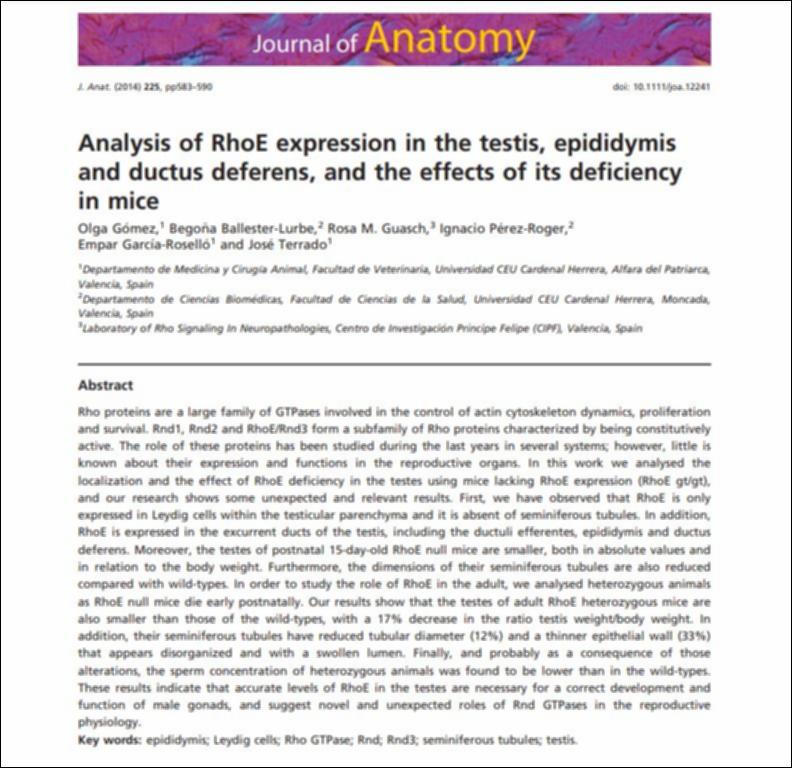Por favor, use este identificador para citar o enlazar este ítem:
http://hdl.handle.net/10637/14956Analysis of RhoE expression in the testis, epididymis and ductus deferens, and the effects of its deficiency in mice

Ver/Abrir:
Analysis_Gomez_JA_2014.JPG
148,53 kB
JPEG
Ver/Abrir:
Analysis_Gomez_JA_2014.pdf
Acceso restringido
1,44 MB
Adobe PDF
Request a copy
| Título : | Analysis of RhoE expression in the testis, epididymis and ductus deferens, and the effects of its deficiency in mice |
| Autor : | Gómez Roda, Olga Ballester Lurbe, Begoña Guasch, Rosa M. Pérez Roger, Ignacio García Roselló, Empar Terrado Vicente, José |
| Materias: | Fisiología; Physiology; Veterinaria; Veterinary medicine; Reproducción humana; Human reproduction; Proteína; Proteins |
| Editorial : | John Wiley & Sons |
| Citación : | Gómez, O., Ballester-Lurbe, B., Guasch, R.M., Pérez-Roger, I., García-Roselló, E., & Terrado, J. (2014). Analysis of RhoE expression in the testis, epididymis and ductus deferens, and the effects of its deficiency in mice. Journal of Anatomy, vol. 225, i. 6 (dec.), pp. 583–590. DOI: https://doi.org/10.1111/joa.12241 |
| Resumen : | Rho proteins are a large family of GTPases involved in the control of actin cytoskeleton dynamics, proliferation and survival. Rnd1, Rnd2 and RhoE/Rnd3 form a subfamily of Rho proteins characterized by being constitutively active. The role of these proteins has been studied during the last years in several systems; however, little is known about their expression and functions in the reproductive organs. In this work we analysed the localization and the effect of RhoE deficiency in the testes using mice lacking RhoE expression (RhoE gt/gt), and our research shows some unexpected and relevant results. First, we have observed that RhoE is only expressed in Leydig cells within the testicular parenchyma and it is absent of seminiferous tubules. In addition, RhoE is expressed in the excurrent ducts of the testis, including the ductuli efferentes, epididymis and ductus deferens. Moreover, the testes of postnatal 15-day-old RhoE null mice are smaller, both in absolute values and in relation to the body weight. Furthermore, the dimensions of their seminiferous tubules are also reduced compared with wild-types. In order to study the role of RhoE in the adult, we analysed heterozygous animals as RhoE null mice die early postnatally. Our results show that the testes of adult RhoE heterozygous mice are also smaller than those of the wild-types, with a 17% decrease in the ratio testis weight/body weight. In addition, their seminiferous tubules have reduced tubular diameter (12%) and a thinner epithelial wall (33%) that appears disorganized and with a swollen lumen. Finally, and probably as a consequence of those alterations, the sperm concentration of heterozygous animals was found to be lower than in the wild-types. These results indicate that accurate levels of RhoE in the testes are necessary for a correct development and function of male gonads, and suggest novel and unexpected roles of Rnd GTPases in the reproductive physiology. |
| Descripción : | Este recurso no está disponible en acceso abierto por política de la editorial. |
| URI : | http://hdl.handle.net/10637/14956 |
| ISSN : | 0021-8782 1469-7580 (Electrónico) |
| Fecha de publicación : | dic-2014 |
| Centro : | Universidad Cardenal Herrera-CEU |
| Aparece en las colecciones: | Dpto. Medicina y Cirugía Animal |
Los ítems de DSpace están protegidos por copyright, con todos los derechos reservados, a menos que se indique lo contrario.

